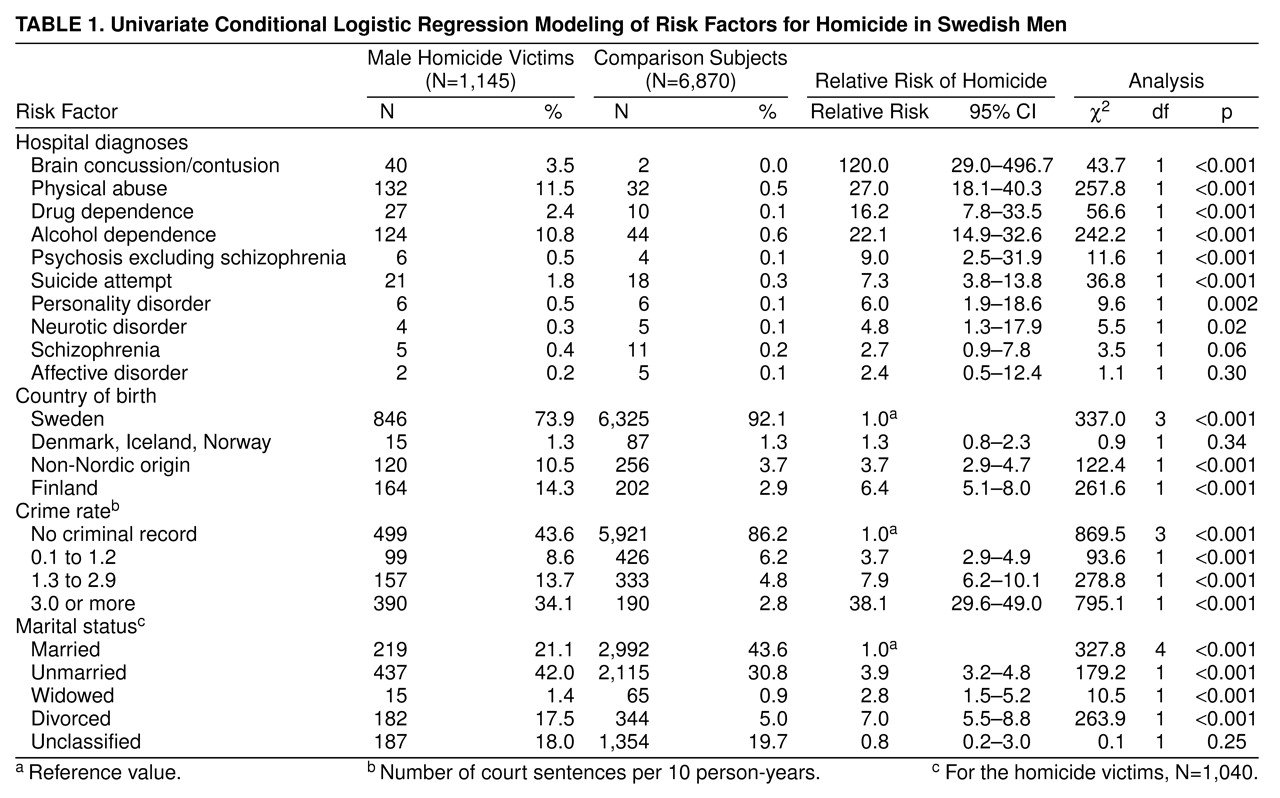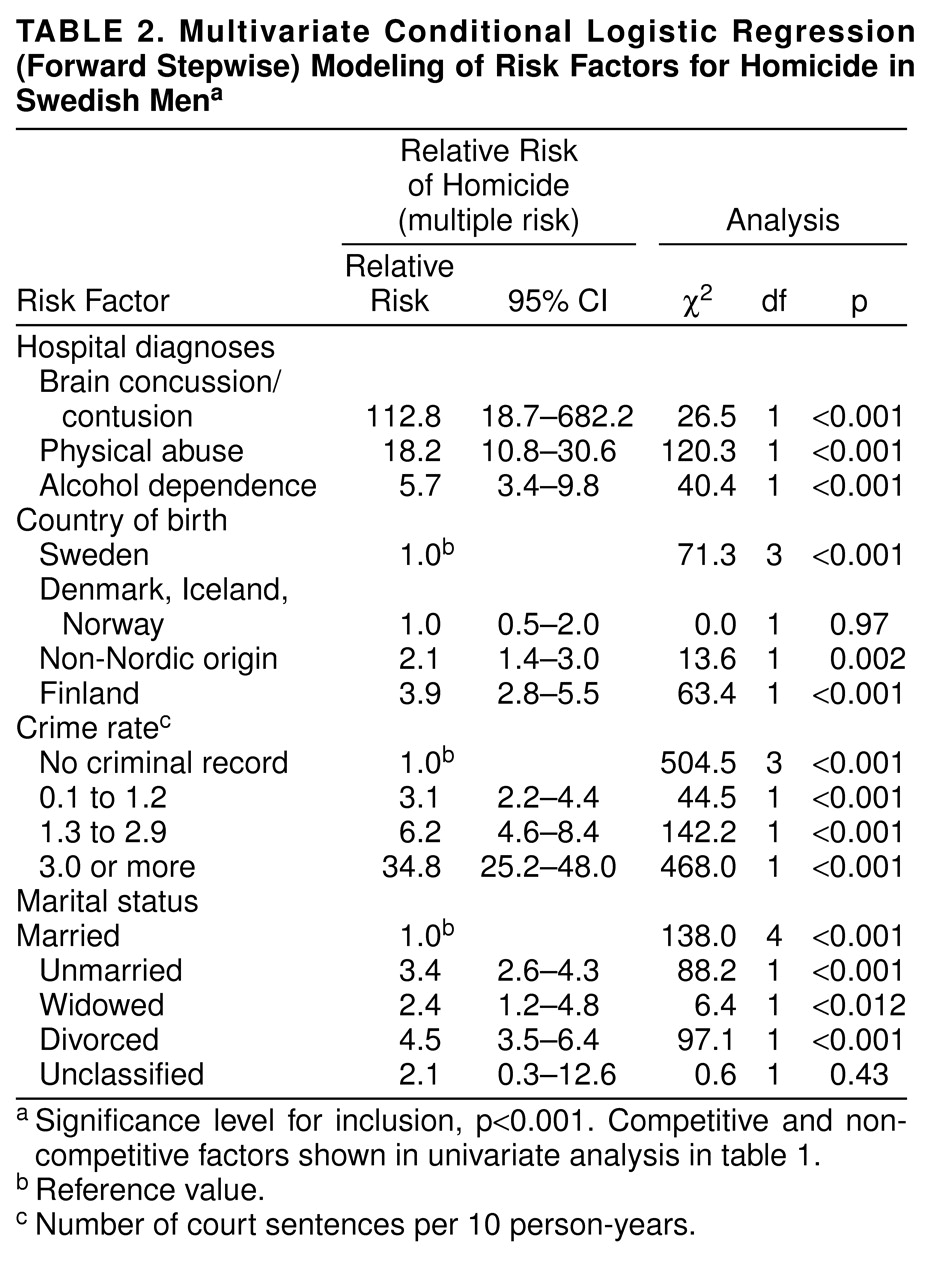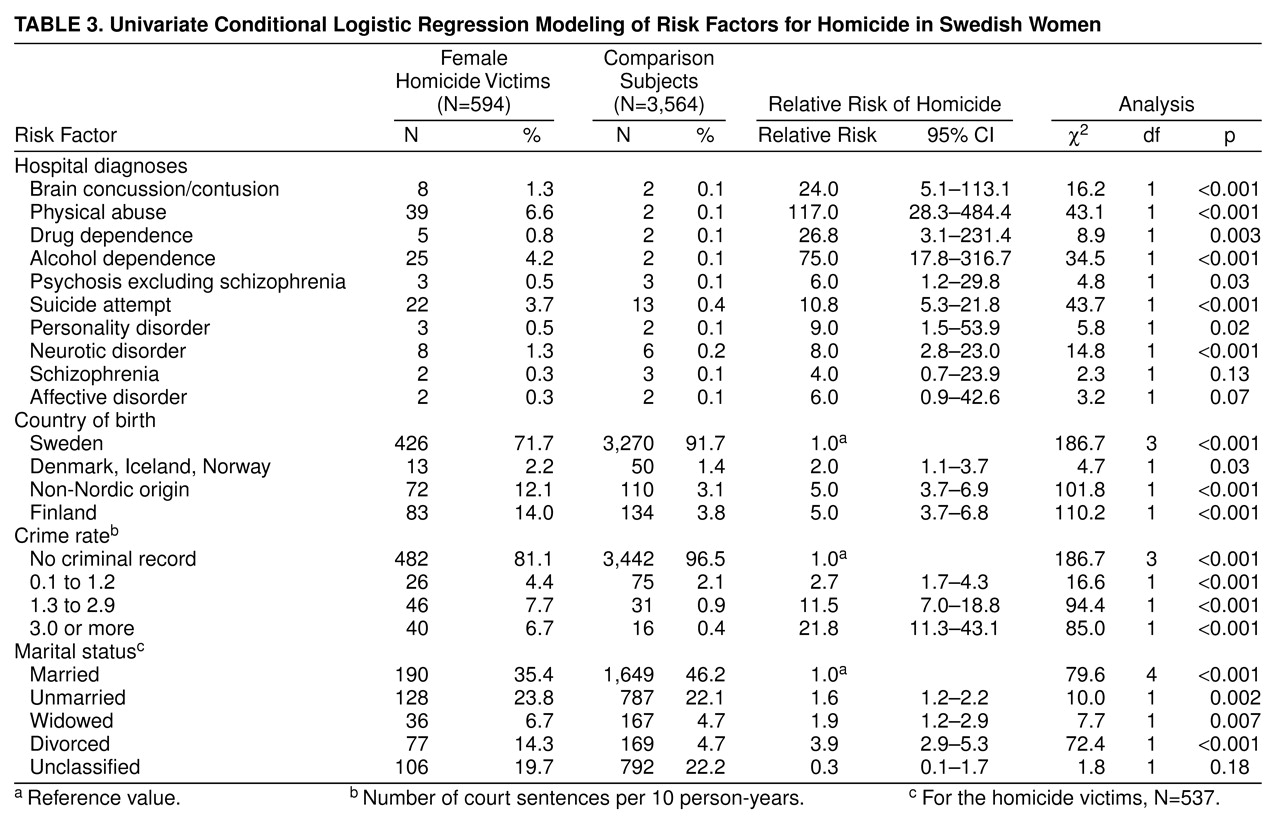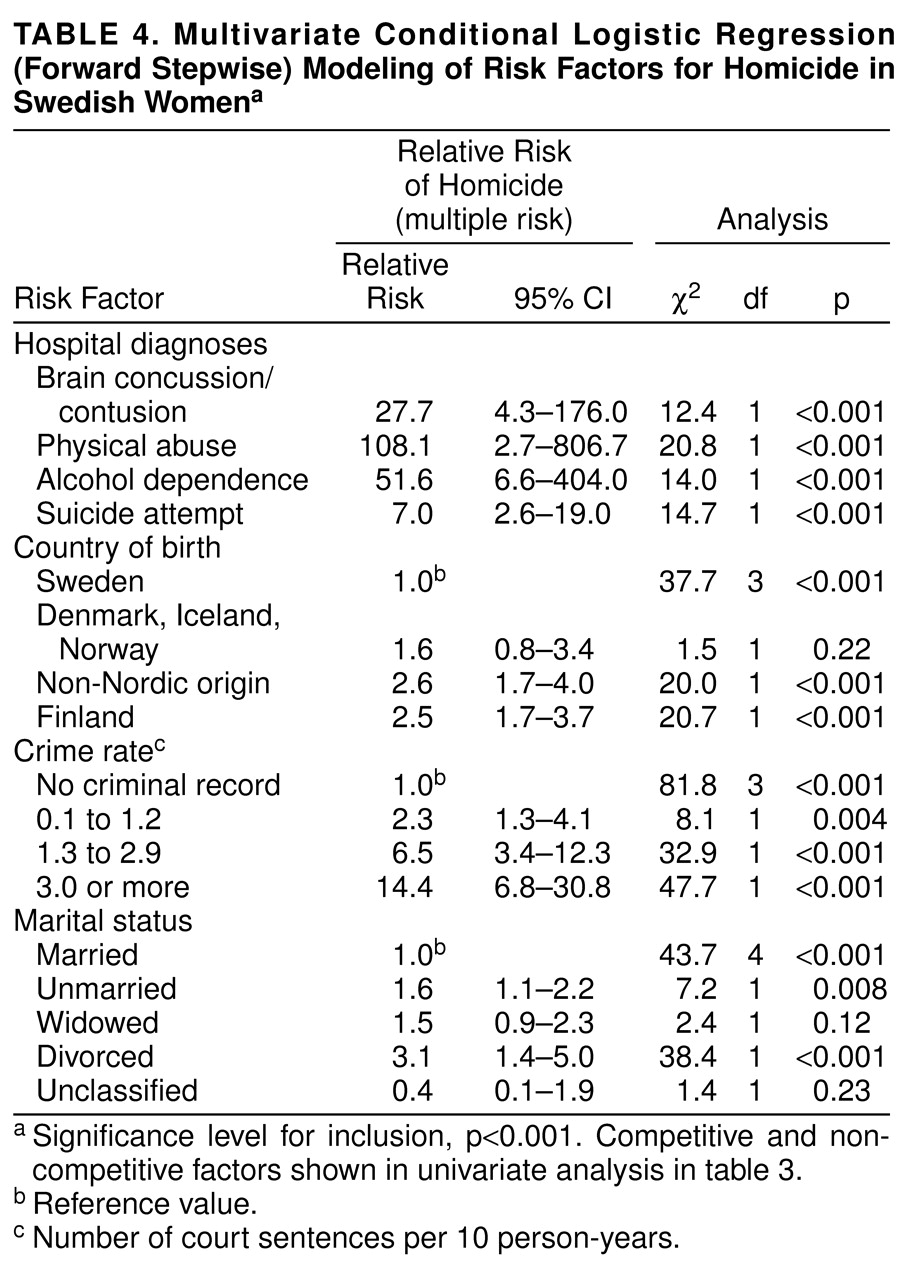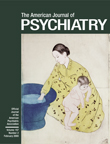This study was undertaken to identify factors contributing to the risk of being murdered in Sweden. The demographic characteristics of the Nordic populations may yield factors other than those true for the United States. There are national health insurance and comprehensive social support systems, immigration is regulated, and the populations were until recently almost entirely Caucasian. Cocaine is hardly available, and handguns are not as common as in the United States. The motives for homicide are similar to those in other cultures: anger during a drunken altercation, jealousy, and revenge
(1,
2). Most victims are killed by their spouses or acquaintances, and usually both the victim and perpetrator are inebriated. Homicide followed by suicide of the perpetrator seems more common than in the United States, perhaps because of the higher proportion of mentally deranged perpetrators in Sweden
(3).
The annual homicide rates per 100,000 adults in 1994 were 4.1 in Finland, 2.2 in Denmark, 1.6 in Norway, and 2.7 in Sweden, compared to 9.4 in the United States
(4). Wikstr�
(5) reported that the higher homicide rate in Philadelphia than in Stockholm during the 1950s was due to intraracial black homicides
(6). Twelve times as many homicides were committed with a weapon in Philadelphia as in Stockholm. Homicides provoked by the victim’s behavior occurred in 26% of the Philadelphia cases, compared to 11% in Stockholm
(6). In a matched case-control study of all 820 cases of firearm injuries in Stockholm over 20 years, murder or attempted murder was the motive in 21%
(7). The homicide rate in Sweden after 1955 has been correlated with the consumption of spirits at home; the attributable fraction has been estimated to be 50%
(8).
The typical risk factors for being murdered in U.S. metropolitan areas are male sex, youth, black or Hispanic ethnicity, household crowding, homelessness, inebriation, drug dealing, handguns, and just living in an environment with these elements
(9–
17).
Our study was undertaken to identify health and social characteristics conferring risk of being murdered in Sweden. There are about 120 criminal homicides per year in a population of 8.6 million, i.e., 1.0 per 100,000 men and 0.5 per 100,000 women. All consecutive adult cases over 16 years were included. We hypothesized that substance abuse, criminality, and immigrant status would be independent risk factors for being murdered in Sweden.
METHOD
All 1,739 persons 18 years and older who resided in Sweden in 1978 and were murdered through 1994 were identified (criminal homicides: ICD E960–E969 as recorded in the national Cause-of-Death Register).
On the basis of sex, year, and month of birth, 1,024 strata were formed within the total Swedish population on Dec. 31, 1977, to find six comparison persons for each homicide victim. Random selection within the strata was performed by means of SAS software (SAS Institute, Cary, N.C.), resulting in a data file with 12,173 persons. Their personal identification numbers were used to retrieve data from a national crime register, from the immigration register, and from the national inpatient register (Statistics Sweden and the National Board of Health and Welfare). The means of personal identification were then removed from the file.
The variables used were sex, year and month of birth and homicide, marital status in December 1977, country of birth, number of criminal court sentences, and inpatient diagnoses between January 1978 and December 1994. The ICD diagnoses from a total of 30,855 hospital admissions were divided into 10 categories reflecting substance abuse, suicide attempts, other psychiatric disorders, brain injuries, and physical abuse.
To permit adjustment for time of exposure, i.e., time to homicide, the comparison persons had to remain alive at least as long as the homicide victims. Univariate and multivariate analyses were performed with conditional logistic regression on the matched pairs
(18).
RESULTS
Of the 1,739 homicide victims, 1,145 were men and 594 women. The most frequent diagnoses in both sexes were physical abuse and alcohol dependence. Finland was the most common country of origin after Sweden. Only 21.1% of the men and 35.4% of the women were married when they were killed. A criminal record was found for 56.4% of the men and 18.9% of the women, as compared to 13.8% for the comparison men and 3.4% of the comparison women.
In the univariate model for male homicide victims, the highest relative risks were admission for traumatic brain injury, a high crime rate, and diagnoses of physical abuse, alcohol dependence, and drug dependence (
table 1). All of these except drug dependence remained statistically significant in the multivariate model (
table 2).
In the univariate model for female homicide victims, the highest risks were physical abuse, alcohol dependence, drug dependence, brain injury, and a high crime rate (
table 3). As for the men, all of these except drug dependence remained significant in the multivariate model (
table 4).
DISCUSSION
The study identified traumatic brain injury as a risk factor for being murdered. This is the first such report, to our knowledge. The study also identified other expected risks, such as crime recidivism, physical abuse, and substance abuse.
The results were not confounded by race. All homicide cases during 16 years were included, and the risks were estimated by comparing the victims with matched persons and controlling for length of exposure. Errors due to mistaken identities, missing records, or faulty entries in the registries are negligible. The diagnoses were made routinely in public inpatient settings. The diagnoses of brain injury and physical abuse were based on physical examinations, X-rays, and witness accounts in cases of such severity that inpatient care was warranted. One limitation of the study is the absence of police reports including forensic examinations.
We have no knowledge of the behavior of the victims at the time of killing. Evolutionary psychologists view homicide as an extreme manifestation of interpersonal conflict or character contest, especially within the family
(19,
20). Criminologists find conflicting results in classifying victim-offender relationships
(21). Tiihonen et al.
(22) proposed that the seasonal variation of the homicide rate in Finland parallels that of variations in CNS serotonin transmission, an impetus for neurophysiological studies of the matter.
Why are brain injuries conducive to homicide? According to one estimate
(23), 1.5 million U.S. residents, mostly young males, sustained nonfatal brain injuries in 1991. A traumatic brain injury may cause long-term irritability, agitation, belligerence, anger, episodic dyscontrol, and inappropriate social responses
(24). Retrospective and prospective studies suggest that traumatic brain injury may be associated with criminal and violent behavior
(25), but to our knowledge, no prior study has elucidated an association with homicide. It seems plausible that aggressive and persevering behavior, compounded by alcohol inebriation, may provoke homicidal acts for trivial reasons in an environment characterized by crime, substance abuse, and poverty.
